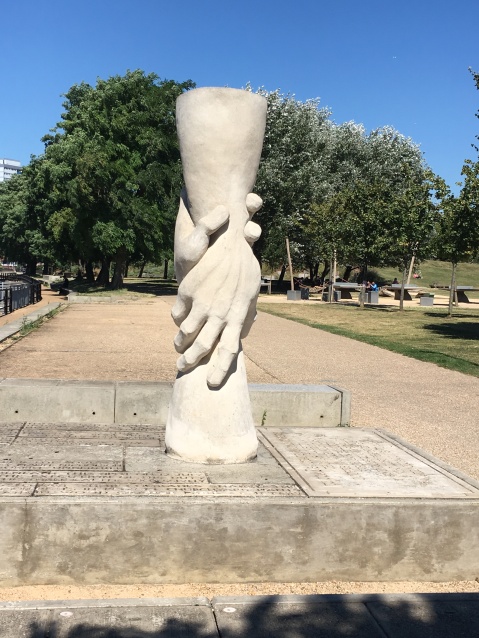
- Helping Hands by Alec Peever 2001
This sculpture of clasped hands on Three Mills Green by Alec Peever, commemorates four tragic deaths in an industrial accident one hundred and sixteen years ago today. On 12th July 1901 three workmen and the Managing Director of the nearby Nicholson’s Gin Distillery met a tragic end.
Today Three Mills is a picturesque spot, a time warp just minutes from the busy Bow Flyover, but it is also part of our earliest industrial heritage. There have been wind and tidal river mills on the site since medieval times, grinding flour, corn and even gunpowder. By the 1730s a distillery was established and gin (made popular by the Dutch king of England, William III) was produced here. From 1872, the business was owned and run by J&W Nicholson of Nicholson’s Gin fame.
-

Clock Mill at low tide
On 12th July 1901, Godfrey Maule Nicholson, Managing Director of the distillery, Albert Dawkins, the foreman and two other workers went to open up a sealed well on a corner of the site to see if it could be used again. The well had fallen out of use a couple of years previously when the London County Council built a sewer nearby and the water dried up. Recently, Mr Nicholson had learned that the sewer was no longer in use and he wanted to see if it would be possible to use the well again. It was a hot summer and the additional water supply would be useful.
A ladder was put down the well and 26 year old Thomas Pickett, one of the labourers, descended with an 11 foot measuring pole to test the water level. As Thomas climbed back up and passed the pole to his foreman, he suddenly collapsed and fell back into the well. Without thought, 29 year old Godfrey Nicholson quickly climbed over and was trying to pull Thomas clear of the water when he too was overcome and fell in. Before Albert Dawkins, the foreman could follow, the second labourer, Joseph Barbour, stopped him suggesting that the men may have been overcome by fumes.
As Dawkins and Barbour ran off to get a rope, and ignoring their entreaties not to go too far down the well un-roped, a third workman, 35 year old George Frederick Elliott descended to try to recover his colleagues but he too was overcome and fell into the water. Despite the, by now obvious, dangers from noxious fumes a fourth man, 24 year old Robert Arthur Underhill, climbed down in another attempt to rescue his fellows and he too slumped into the water.
Thankfully, a rope was found and although the next man down, Job Vanning was also quickly overcome by the gases, he could be pulled clear by his colleagues and escaped drowning. When he recovered he said there had been no apparent smell but he had felt suddenly sleepy. He had no recollection of being pulled out of the well.
The Fire Brigade retrieved the bodies of the four men who were certified dead at the scene by local doctor Francis J Hilliard. At the inquest held the following Saturday, the jury returned verdicts of accidental death for all four men and expressed regret that the precaution of lighting a candle to test for the presence of gas, had not been employed.
The Coroner, Mr Attwater praised the bravery of those who had gone down the well to try to rescue their colleagues and the courage of Mr Vanning.
Alec Peever’s sculpture, erected in 2001, one hundred years after the tragedy, replaced an earlier monument a short distance away at the exact site of the well. This is now marked by a simple plaque.

- Site of the well
Stone tablets from the original monument have been incorporated into the new memorial, including the following inscription:
“Of your charity pray for the souls of Thomas Pickett, Godfrey Maule Nicholson, Frederick Elliott and Robert Underhill, who lost their lives in a well beneath this spot on 12 July 1901. The first named while in the execution of his duty was overcome by foul air. The three latter successively descending in heroic efforts to save their comrades shared the same death.”
The valour of Elliott, Nicholson and Underhill is also commemorated in Victorian artist, GF Watts’ memorial to acts of heroic self sacrifice at Postman’s Park in the City of London.
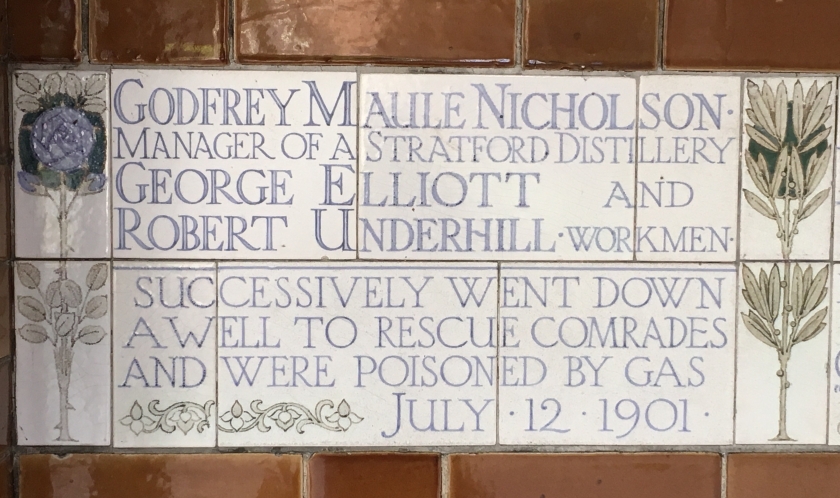
- Plaque in Postman’s Park
Godfrey Nicholson was buried in his home parish at Holy Trinity Church, Privett, Hampshire where he is commemorated by a stained glass window and a marble plaque.
The three workmen who died were all buried locally in Woodgrange Park Cemetery where they appear to have no lasting monument. Sadly, much of the privately-owned 29 acre cemetery is in a very dilapidated state.

- Overgrown and damaged graves at Woodgrange Park Cemetery
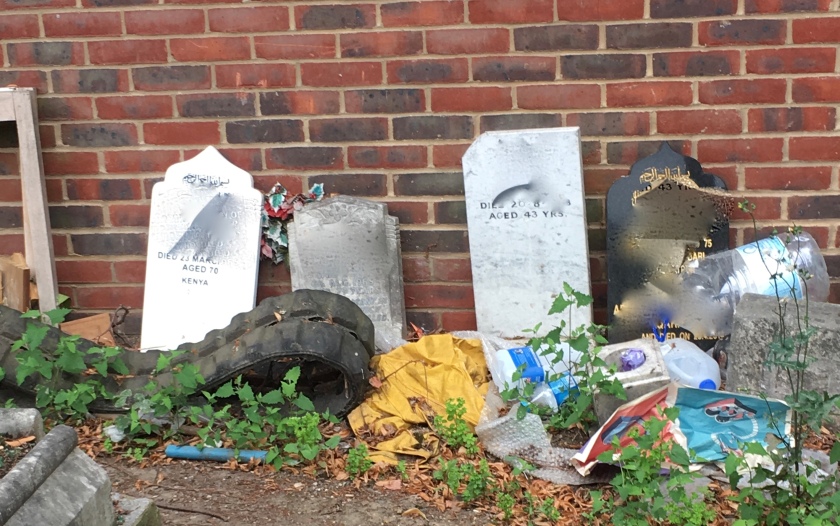
- Headstones at Woodgrange Park Cemetery
Graves are overgrown by brambles, headstones are broken and jumbled and many paths are no longer passable. Despite efforts by the Friends of Woodgrange Park Cemetery an Act of Parliament passed in 1993 allowed part of the site to be sold off for redevelopment as flats.
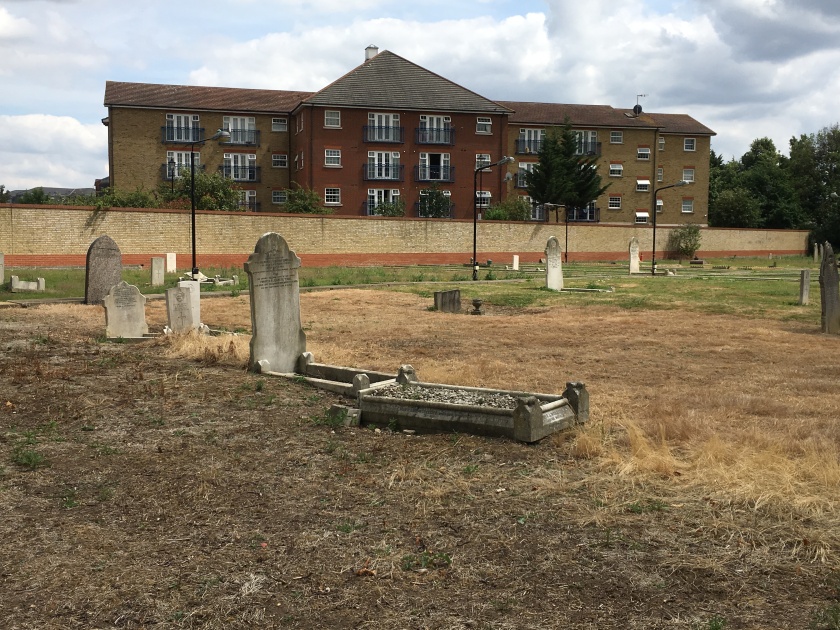
- New flats on land sold by Woodgrange Park Cemetery
The remains of those who had been buried in this area were removed and have been re-interred in the so-called Garden of Remembrance – a long strip of rough, yellowing grass marked with a single small memorial stone.
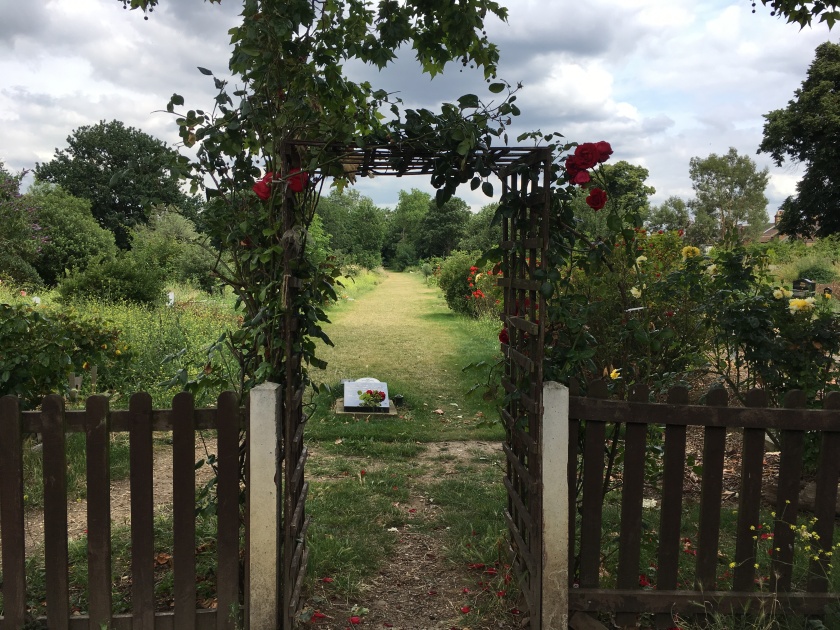
- The “Garden of Remembrance” Woodgrange Park Cemetery
Sadly, and perhaps especially after the care taken elsewhere to record the bravery of these four men, a visit to the cemetery where three of them were interred is a profoundly dispiriting experience.
Art and Industry in East London – guided walk 22nd July 2017
